Numerical Assessment of the Effect of CFRP Anchorages on the Flexural and Shear Strengthening Performance of RC Beams
Abstract
:1. Introduction
2. Testing Framework
2.1. Details of Experimental Beams
2.2. Measurement Instrumentation
2.3. Key Experimental Findings
3. Finite Element Simulation
3.1. Summary of Concrete Damage Plasticity Framework and Constitutive Material Models

3.2. Discretization of the Model, Boundary Conditions, and Parameter Specifications
4. Modeling Results
4.1. Impact of Bonding Interfaces on the Behavior of U-Shaped CFRP Strips
4.2. Beam with Anchorage System: SFSA-I and SFSA-II Beams
4.3. Beams Behavior in Terms of Strain–Load Relationship
5. Numerical Parametric Study
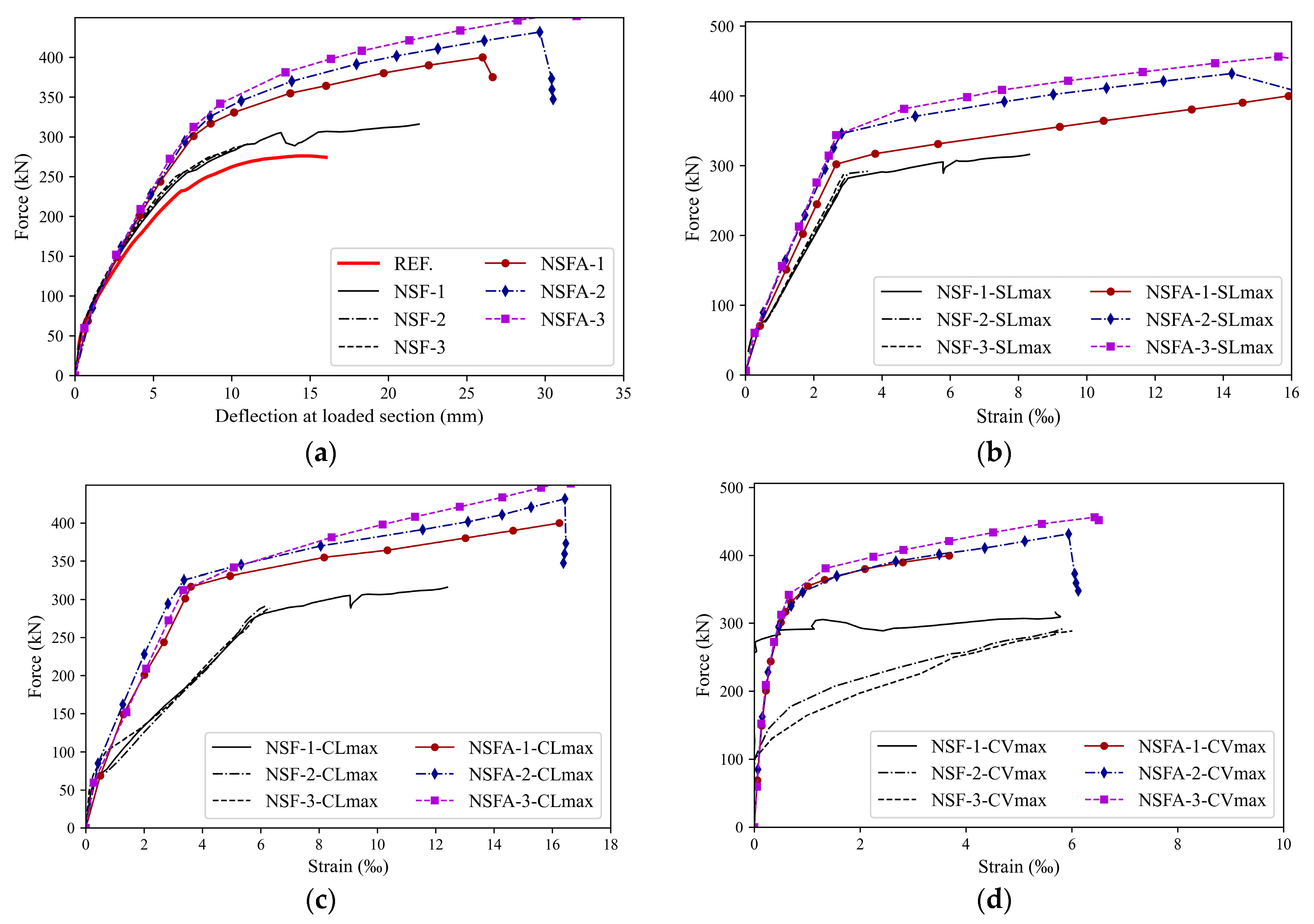

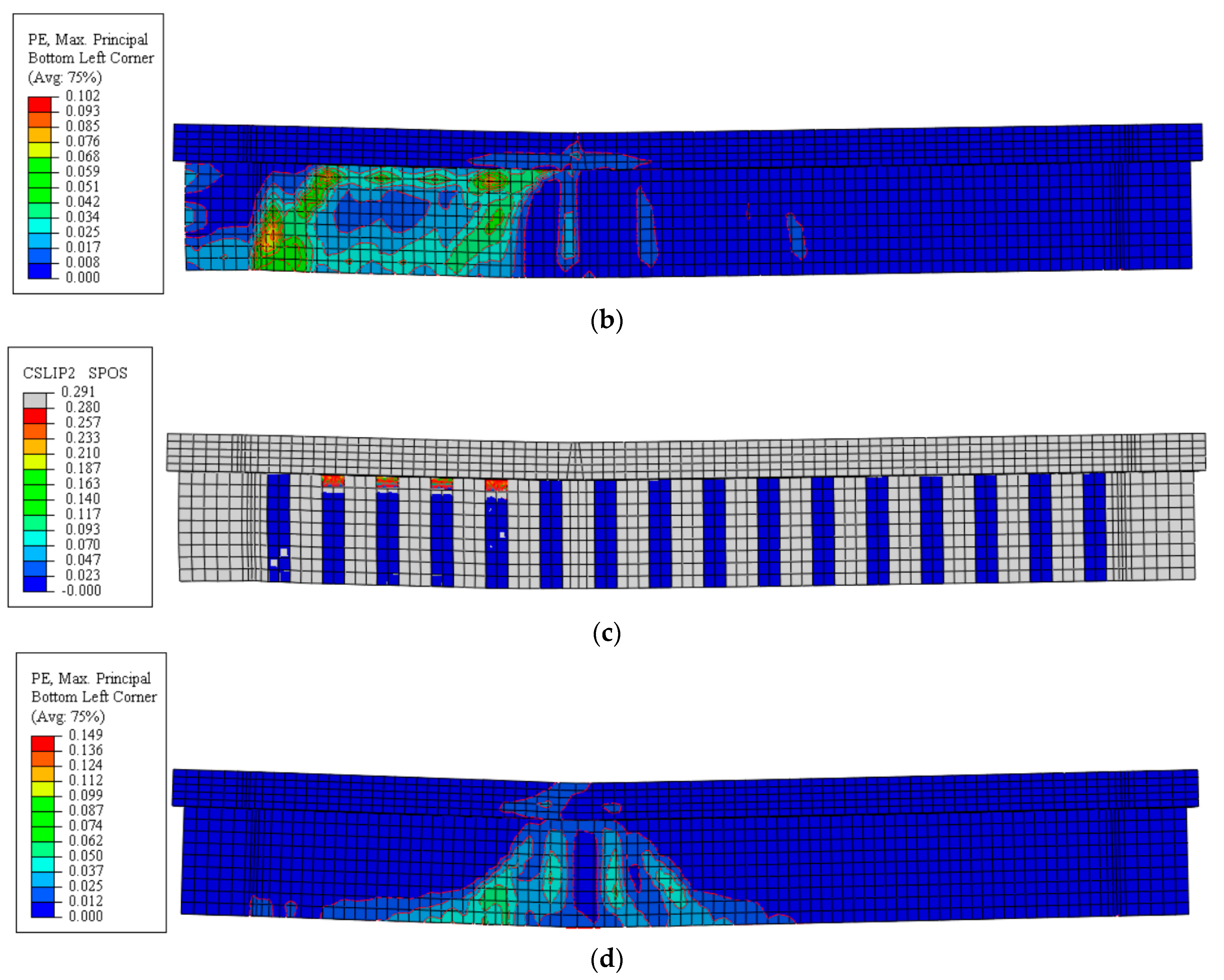
6. Conclusions
- The Concrete Damage Plasticity (CDP) model was employed to simulate the behavior of these beams, with a detailed examination of the influence of finite element mesh refinement and CFRP bond conditions on the numerical results.
- It was observed that reducing the finite element size tends to decrease the predicted load-carrying capacity of the beams. A mesh with elements less than three times the maximum dimension of the concrete aggregates provided a good balance between accuracy and computational efficiency.
- The bond conditions of the CFRP strips were critically evaluated. The bond law proposed by fib Bulletin 90 was found to predict premature debonding and failure, highlighting the sensitivity of the beams’ load-carrying capacity to the parameters defining this bond law. Suitable parameter values were determined through inverse analysis to accurately capture key results, including force vs. deflection behavior and failure modes.
- Numerical simulations confirmed that the CFRP anchors provided effective bonding conditions for the U-shaped strips. However, it was necessary to reduce the modulus of elasticity of the CFRP in the anchorage by 20–30% to reflect real stiffness, acknowledging challenges in perfect material placement in the anchorage zone.
- Using the calibrated CDP model, a parametric study assessed the predictive accuracy of the fib Bulletin 90 and ACI 440.2R-17 formulations for designing flexural and shear strengthening solutions. The ratio between the numerically predicted maximum load and the load determined by the ACI and fib formulations was 1.10 and 1.08, respectively, with CoV values of 0.18 and 0.17.
- Future studies should explore the impact of varying CFRP anchorage configurations and bond parameters on the long-term performance of strengthened RC beams under different loading conditions, including fatigue and environmental effects. Additionally, the development and validation of other numerical models (e.g., smeared crack for concrete and advanced bond criteria) that can more accurately simulate the complex interactions of the concrete behavior itself and the CFRP–concrete interface would be beneficial for refining design guidelines and improving the reliability of CFRP strengthening techniques.
Author Contributions
Funding
Data Availability Statement
Acknowledgments
Conflicts of Interest
Appendix A
Appendix A.1. NSF-1 Beam
Appendix A.1.1. ACI 440.2R-17 Formulation
Appendix A.1.2. fib Bulletin 90
Appendix A.2. NSFA-1 Beam
Appendix A.2.1. ACI 440.2R-17 Formulation
Appendix A.2.2. fib Bulletin 90
References
- Barros, J.A.O.; Dias, S.J.E.; Lima, J.L.T. Efficacy of CFRP-based techniques for the flexural and shear strengthening of concrete beams. Cem. Concr. Compos. 2007, 29, 203–217. [Google Scholar] [CrossRef]
- Dias, S.; Barros, J. Performance of reinforced concrete T beams strengthened in shear with NSM CFRP laminates. Eng. Struct. 2010, 32, 373–384. [Google Scholar] [CrossRef]
- Bakis, C.E.; Bank, L.C.; Brown, V.L.; Cosenza, E.; Davalos, J.F.; Lesko, J.J.; Machida, A.; Rizkalla, S.H.; Triantafillou, T.C. Fiber-Reinforced Polymer Composites for Construction—State-of-the-Art Review. J. Compos. Constr. 2003, 6, 73–87. [Google Scholar] [CrossRef]
- Muciaccia, G.; Khorasani, M.; Mostofinejad, D. Effect of different parameters on the performance of FRP anchors in combination with EBR-FRP strengthening systems: A review. Constr. Build. Mater. 2022, 354, 129181. [Google Scholar] [CrossRef]
- Bilotta, A.; Ceroni, F.; Nigro, E.; Pecce, M. Efficiency of CFRP NSM strips and EBR plates for flexural strengthening of RC beams and loading pattern influence. Compos. Struct. 2015, 124, 163–175. [Google Scholar] [CrossRef]
- Khalifa, A.M. Flexural performance of RC beams strengthened with near surface mounted CFRP strips. Alex. Eng. J. 2016, 55, 1497–1505. [Google Scholar] [CrossRef]
- Sharaky, I.A.; Torres, L.; Comas, J.; Barris, C. Flexural response of reinforced concrete (RC) beams strengthened with near surface mounted (NSM) fibre reinforced polymer (FRP) bars. Compos. Struct. 2014, 109, 8–22. [Google Scholar] [CrossRef]
- Sun, W.; Lou, T.; Achintha, M. A novel strong and durable near-surface mounted (NSM) FRP method with cost-effective fillers. Compos. Struct. 2021, 255, 112952. [Google Scholar] [CrossRef]
- Polskoy, P.P.; Mailyan, D.; Beskopylny, A.N.; Meskhi, B. Bearing Capacity of Reinforced Concrete Beams with Initial Cracks Reinforced with Polymer Composite Materials. Polymers 2022, 14, 3337. [Google Scholar] [CrossRef]
- Wang, H.-T.; Guo, C.-C.; Liu, Q.-L.; Wu, Q. Influences of the bond-slip on the flexural performance of CFRP plate-strengthened damaged steel beams with intermediate debonding: A numerical study. Structures 2023, 58, 105661. [Google Scholar] [CrossRef]
- Teng, J.; Yu, T.; Fernando, D. Strengthening of steel structures with fiber-reinforced polymer composites. J. Constr. Steel Res. 2012, 78, 131–143. [Google Scholar] [CrossRef]
- Bianco, V.; Barros, J.; Monti, G. Three dimensional mechanical model for simulating the NSM FRP strips shear strength contribution to RC beams. Eng. Struct. 2009, 31, 815–826. [Google Scholar] [CrossRef]
- Dias, S.; Silva, J.; Barros, J. Flexural and shear strengthening of reinforced concrete beams with a hybrid CFRP solution. Compos. Struct. 2021, 256, 113004. [Google Scholar] [CrossRef]
- Akbarpour, A.; Volz, J.; Vemuganti, S. An Experimental Study Incorporating Carbon Fiber Composite Bars and Wraps for Concrete Performance and Failure Insight. J. Compos. Sci. 2024, 8, 174. [Google Scholar] [CrossRef]
- Salib, M.N. Flexural Behavior of RC T-Section Beams Strengthened with Different Configurations of CFRP Laminates. Int. J. Curr. Eng.Technol. 2012, 2, 418–426. [Google Scholar]
- Barros, J.A.O.; Dias, S.J.E.; Baghi, H.; Ventura-Gouveia, A. New Shear Strengthening Configurations of Near-Surface-Mounted CFRP Laminates for RC Beams. ACI Struct. J. 2016, 113, 1275–1287. [Google Scholar] [CrossRef]
- Shomali, A.; Mostofinejad, D.; Esfahani, M.R. Effective strain of CFRP in RC beams strengthened in shear with NSM reinforcements. Structures 2020, 23, 635–645. [Google Scholar] [CrossRef]
- Sabol, P.; Priganc, S. Shear Strengthening of Concrete Members Using NSM Method. Procedia Eng. 2013, 65, 364–369. [Google Scholar] [CrossRef]
- Triantafyllou, G.G.; Rousakis, T.C.; Karabinis, A.I. Effect of patch repair and strengthening with EBR and NSM CFRP laminates for RC beams with low, medium and heavy corrosion. Compos. Part B Eng. 2018, 133, 101–111. [Google Scholar] [CrossRef]
- Alwash, D.; Kalfat, R.; Al-Mahaidi, R.; Du, H. Shear strengthening of RC beams using NSM CFRP bonded using cement-based adhesive. Constr. Build. Mater. 2021, 301, 124365. [Google Scholar] [CrossRef]
- Arslan, M.H.; Yazman, Ş.; Hamad, A.A.; Aksoylu, C.; Özkılıç, Y.O.; Gemi, L. Shear strengthening of reinforced concrete T-beams with anchored and non-anchored CFRP fabrics. Structures 2022, 39, 527–542. [Google Scholar] [CrossRef]
- Kotynia, R.; Oller, E.; Marí, A.; Kaszubska, M. Efficiency of shear strengthening of RC beams with externally bonded FRP materials–State-of-the-art in the experimental tests. Compos. Struct. 2021, 267, 113891. [Google Scholar] [CrossRef]
- Naser, M.Z.; Hawileh, R.A.; Abdalla, J. Modeling Strategies of Finite Element Simulation of Reinforced Concrete Beams Strengthened with FRP: A Review. J. Compos. Sci. 2021, 5, 19. [Google Scholar] [CrossRef]
- Abbasi, A.; Benzeguir, Z.E.A.; Chaallal, O.; El-Saikaly, G. FE Modelling and Simulation of the Size Effect of RC T-Beams Strengthened in Shear with Externally Bonded FRP Fabrics. J. Compos. Sci. 2022, 6, 116. [Google Scholar] [CrossRef]
- Assad, M.; Hawileh, R.; Abdalla, J. Finite Element Simulation of FRP-Strengthened Thin RC Slabs. J. Compos. Sci. 2022, 6, 263. [Google Scholar] [CrossRef]
- Fib Bulletin 90. Externally Applied FRP Reinforcement for Concrete Structures, fib Task Group 5.1: Lausanne, Switzerland, 2019.
- ACI 440.2R-17; Guide for the Design and Construction of Externally Bonded FRP Systems for Strengthening Concrete Structures. American Concrete Institute: Farmington Hills, MI, USA, 2017.
- Collins, M.P.; Mitchell, D. Pre-Stressed Concrete Structures; Prentice Hall: Englewood Cliffs, NJ, USA, 1991; Volume 9. [Google Scholar]
- Kani, G.N.J. The Riddle of Shear Failure and its Solution. ACI J. Proc. 1964, 61, 441–468. [Google Scholar] [CrossRef]
- Eslami, A.; Moghavem, A.; Shayegh, H.R.; Ronagh, H.R. Effect of FRP stitching anchors on ductile performance of shear-deficient RC beams retrofitted using FRP U-wraps. Structures 2020, 23, 407–414. [Google Scholar] [CrossRef]
- Smith, M. ABAQUS/Standard User’s Manual, Version 2023; Dassault Systèmes Simulia Corp.: Johnston, RI, USA, 2023. [Google Scholar]
- Mander, J.B.; Priestley, M.J.N.; Park, R. Conducted Providing the Stress-Strain Model for Confined Concrete. J. Struct. Eng. 1988, 114, 1804–1826. [Google Scholar] [CrossRef]
- Fib Bulletin 70. Code-Type Models for Concrete Behavior, Task Group 8.7: Lausanne, Switzerland, 2013.
- Lee, J.; Fenves, G.L. Plastic-Damage Model for Cyclic Loading of Concrete Structures. J. Eng. Mech. 1998, 124, 892–900. [Google Scholar] [CrossRef]
- Kupfer, H.; Hilsdorf, H.K.; Rusch, H. Behavior of concrete under biaxial stresses. J. Proc. 1969, 66, 656–666. [Google Scholar] [CrossRef]
- Barros, J.; Sanz, B.; Filho, M.; Figueiredo, F.; Kabele, P.; Yu, R.C.; Meschke, G.; Planas, J.; Cunha, V.; Caggiano, A.; et al. Blind competition on the numerical simulation of continuous shallow steel-fiber reinforced concrete beams failing in bending. Struct. Concr. 2023, 24, 3877–3907. [Google Scholar] [CrossRef]

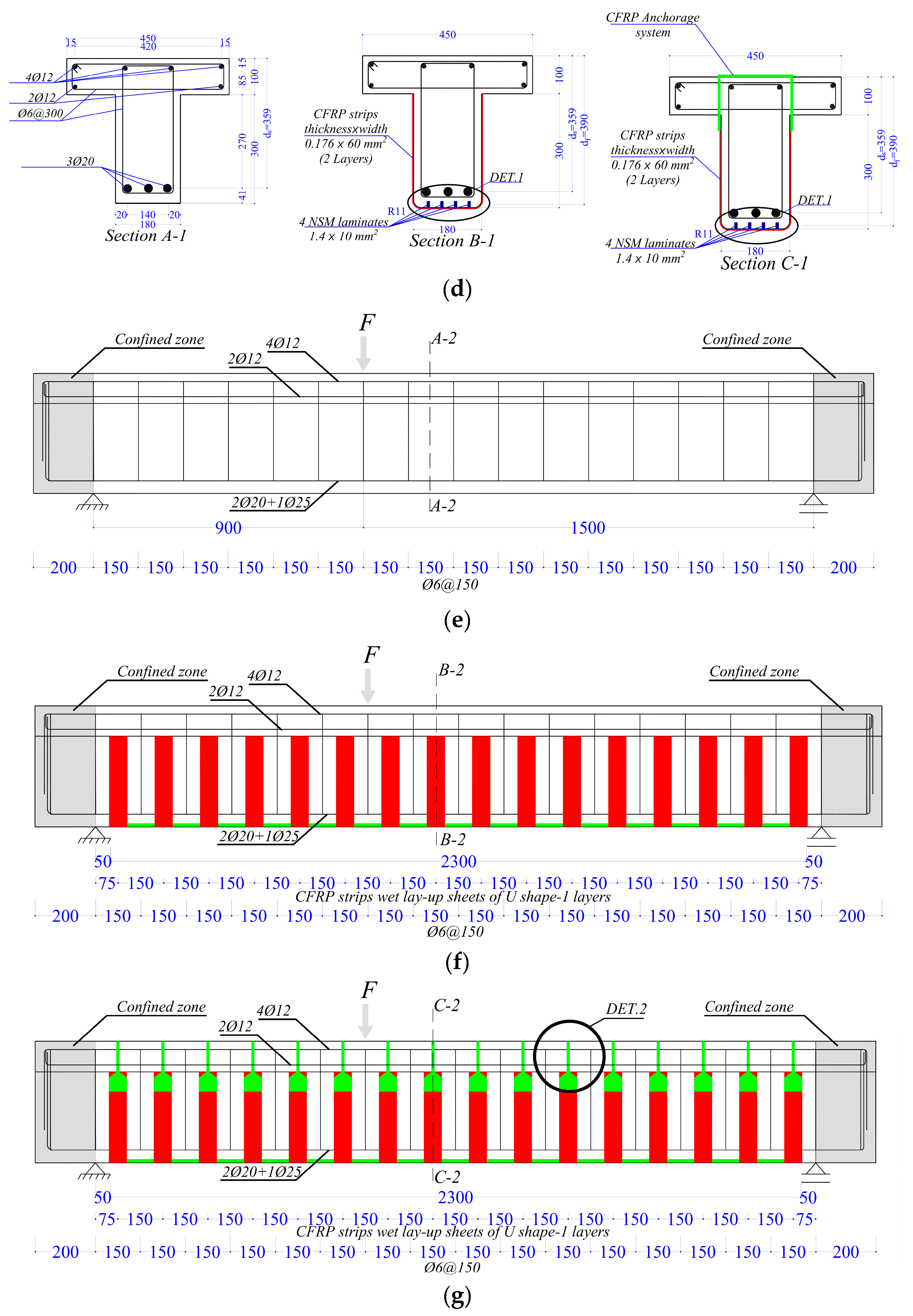

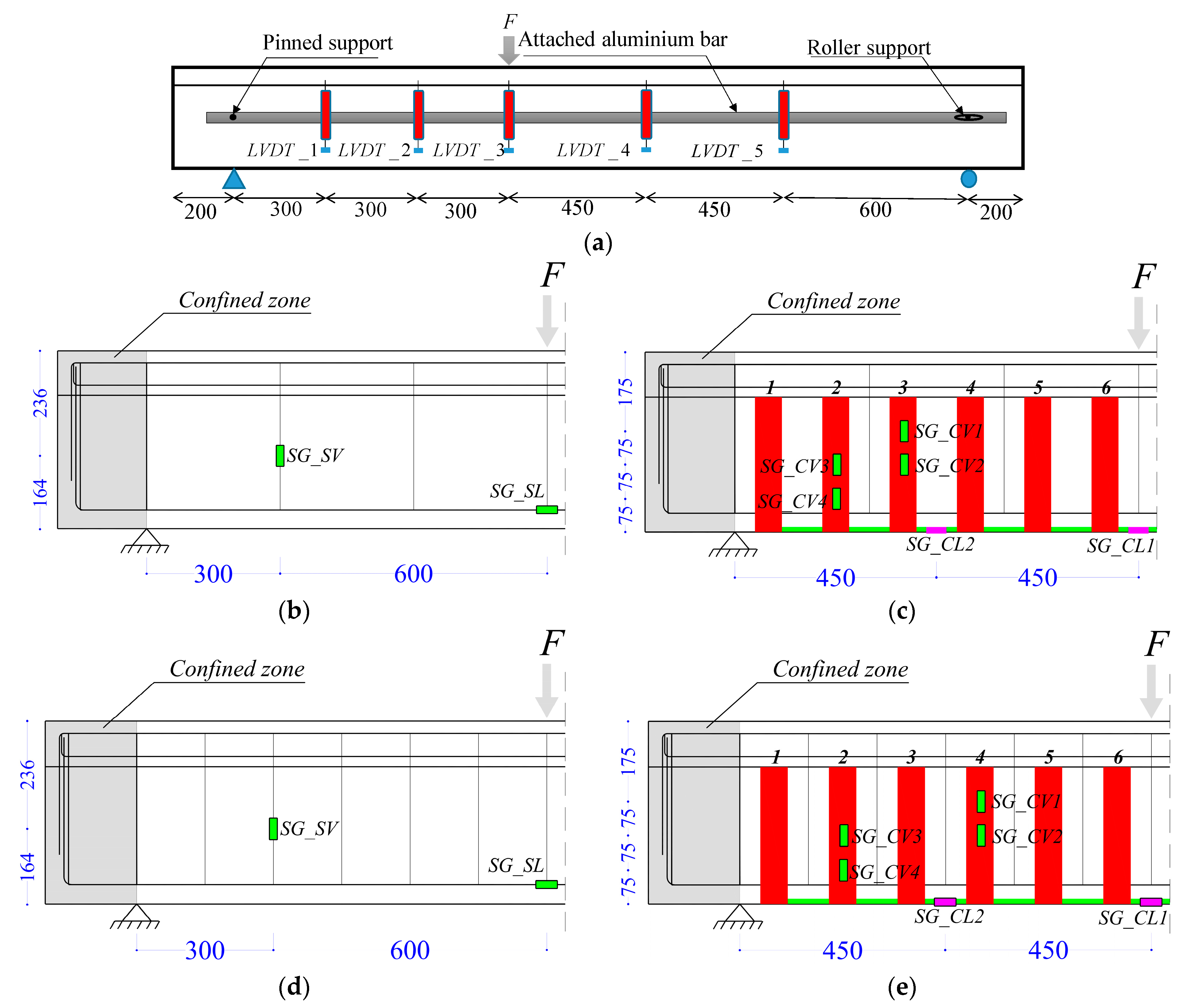
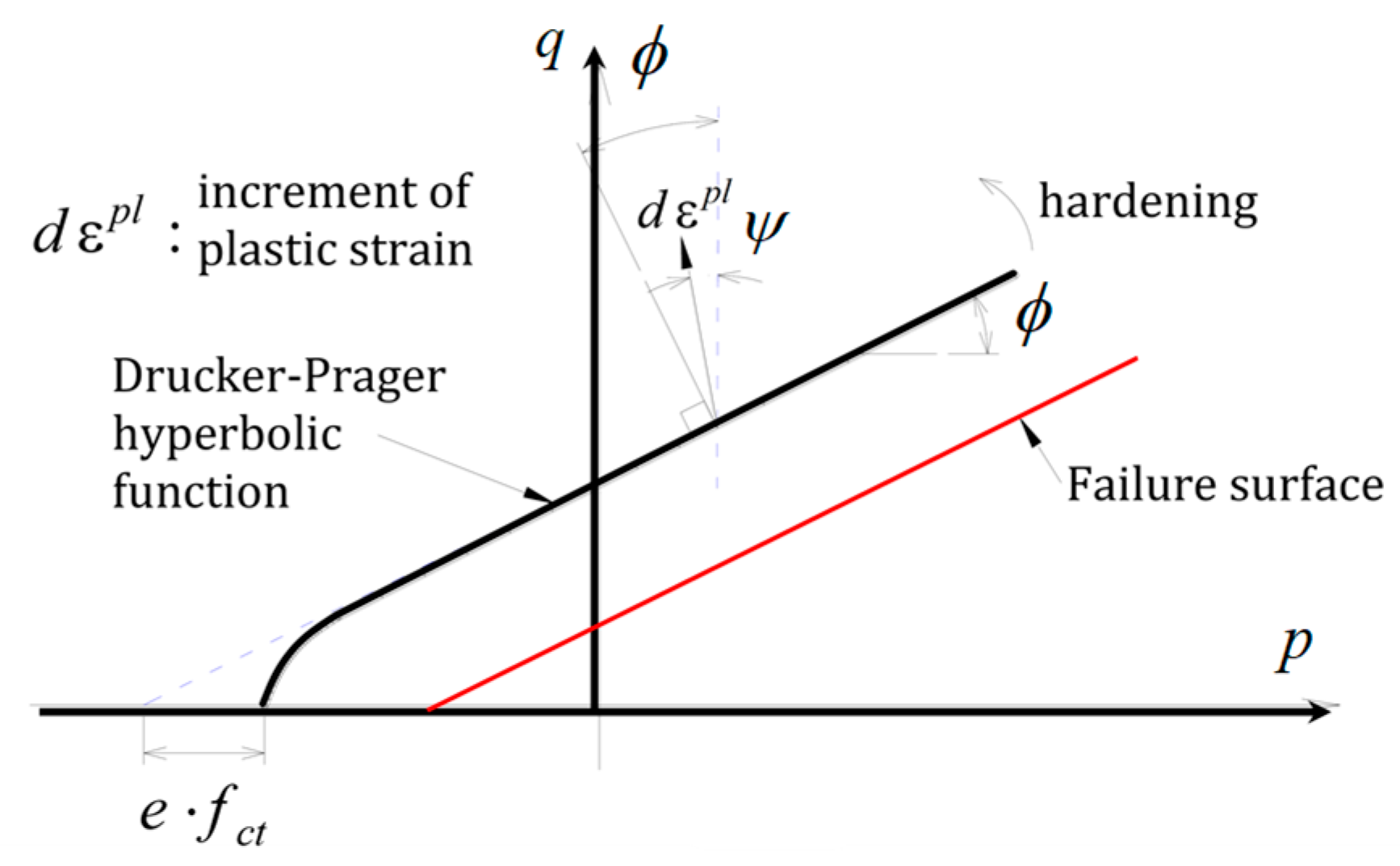

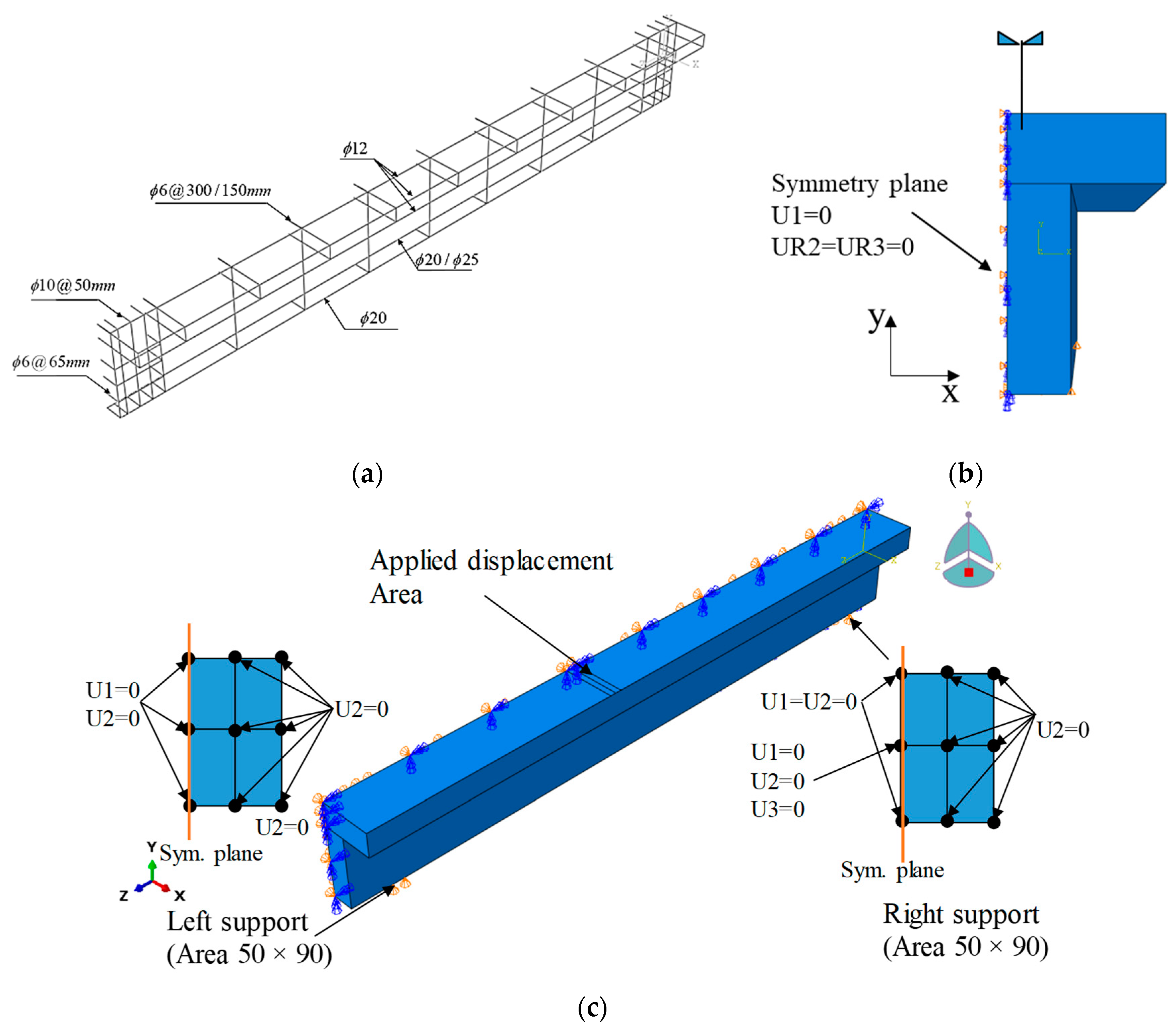
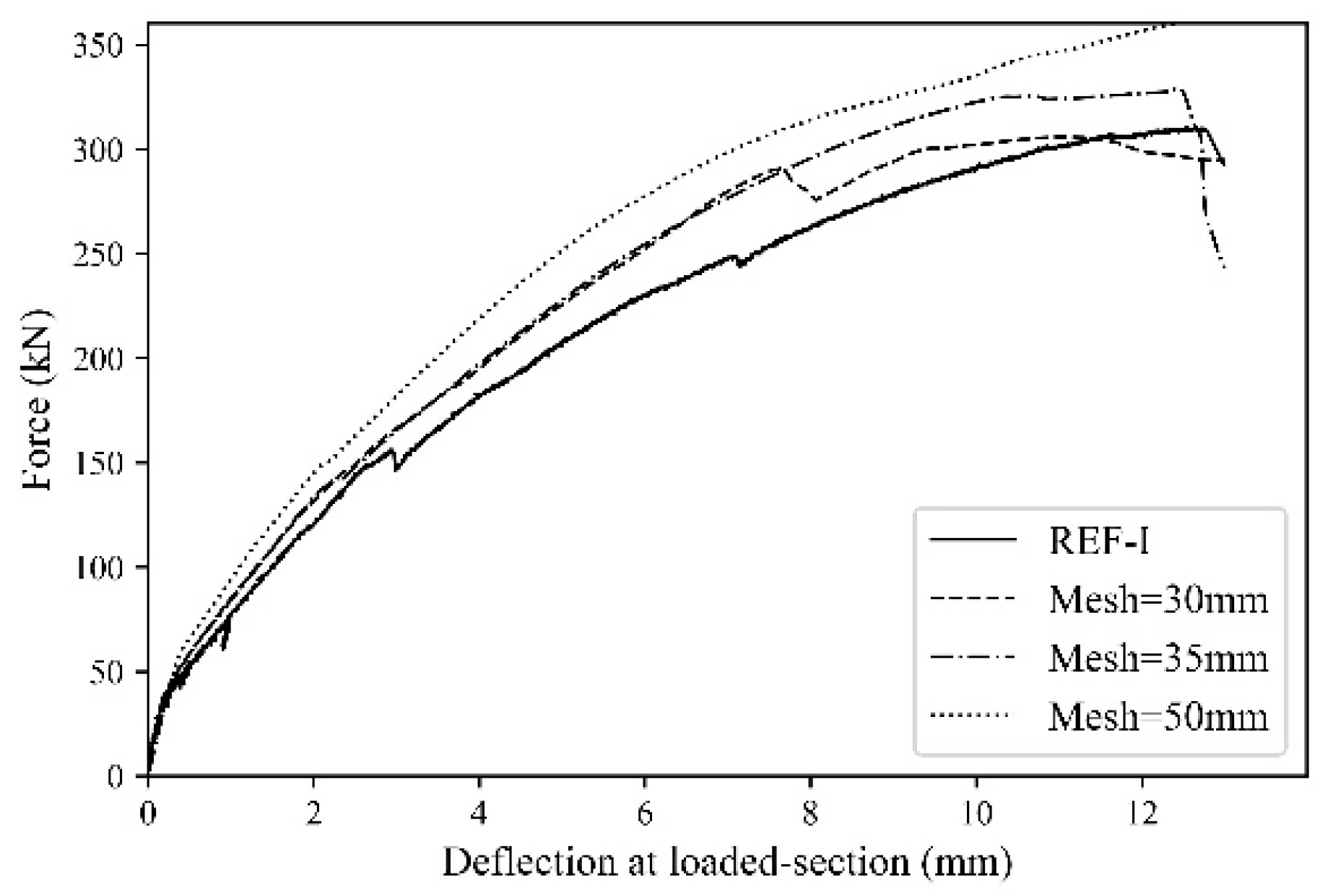


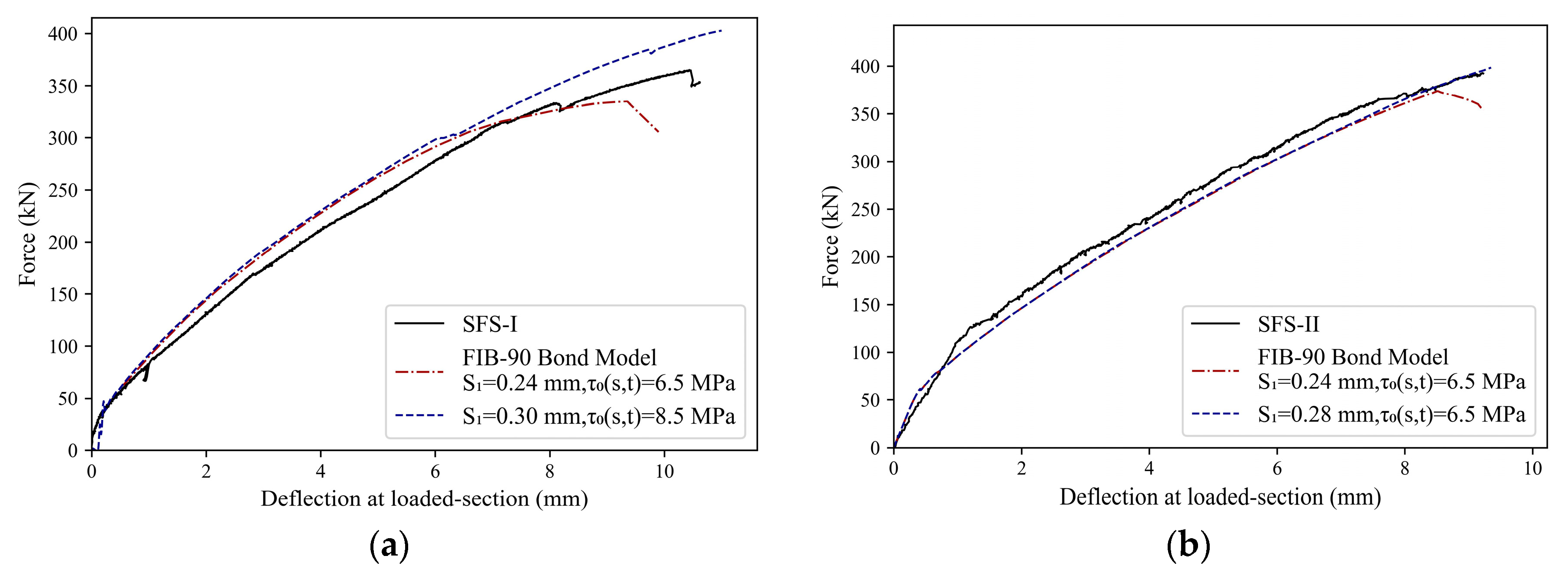

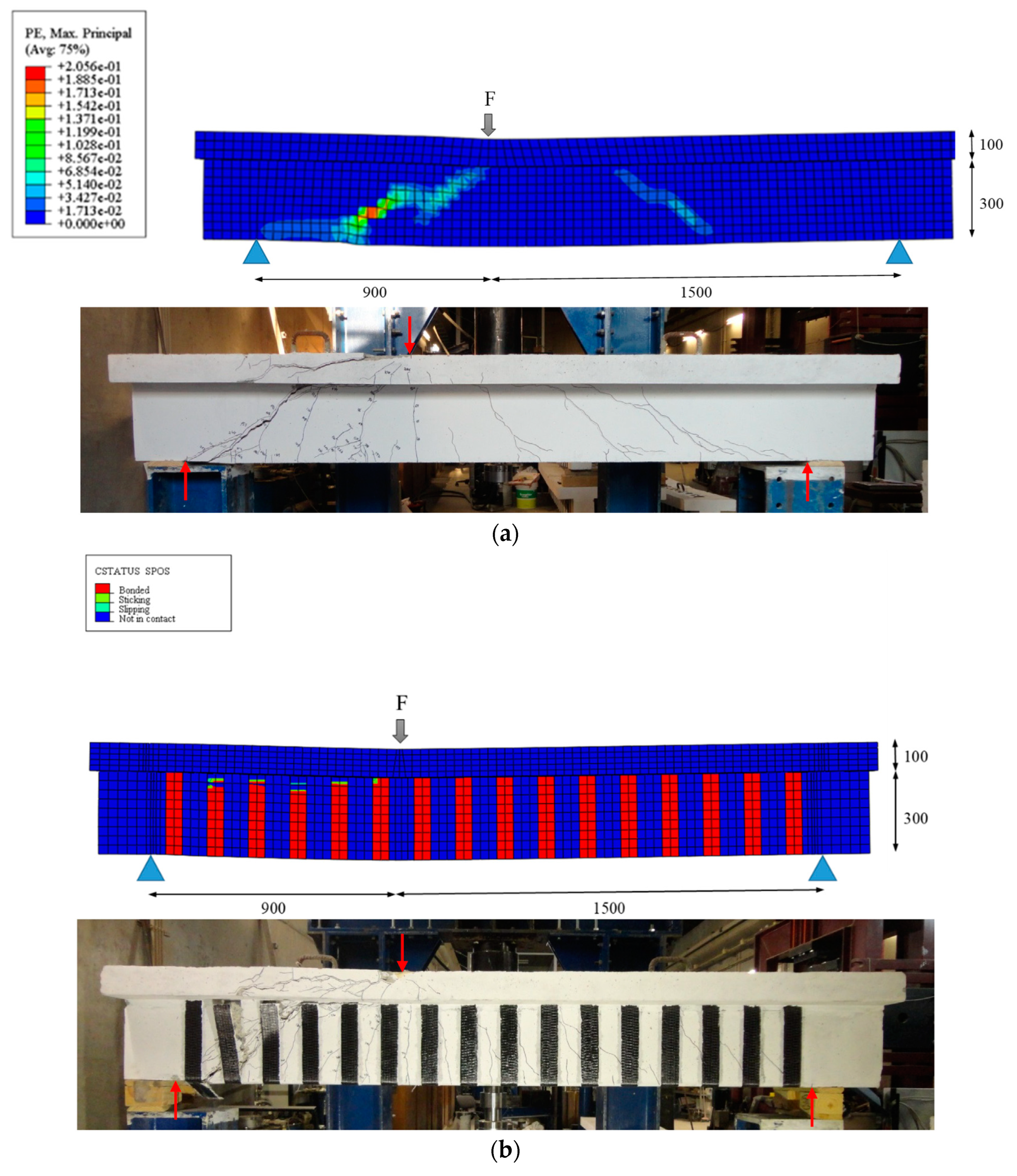

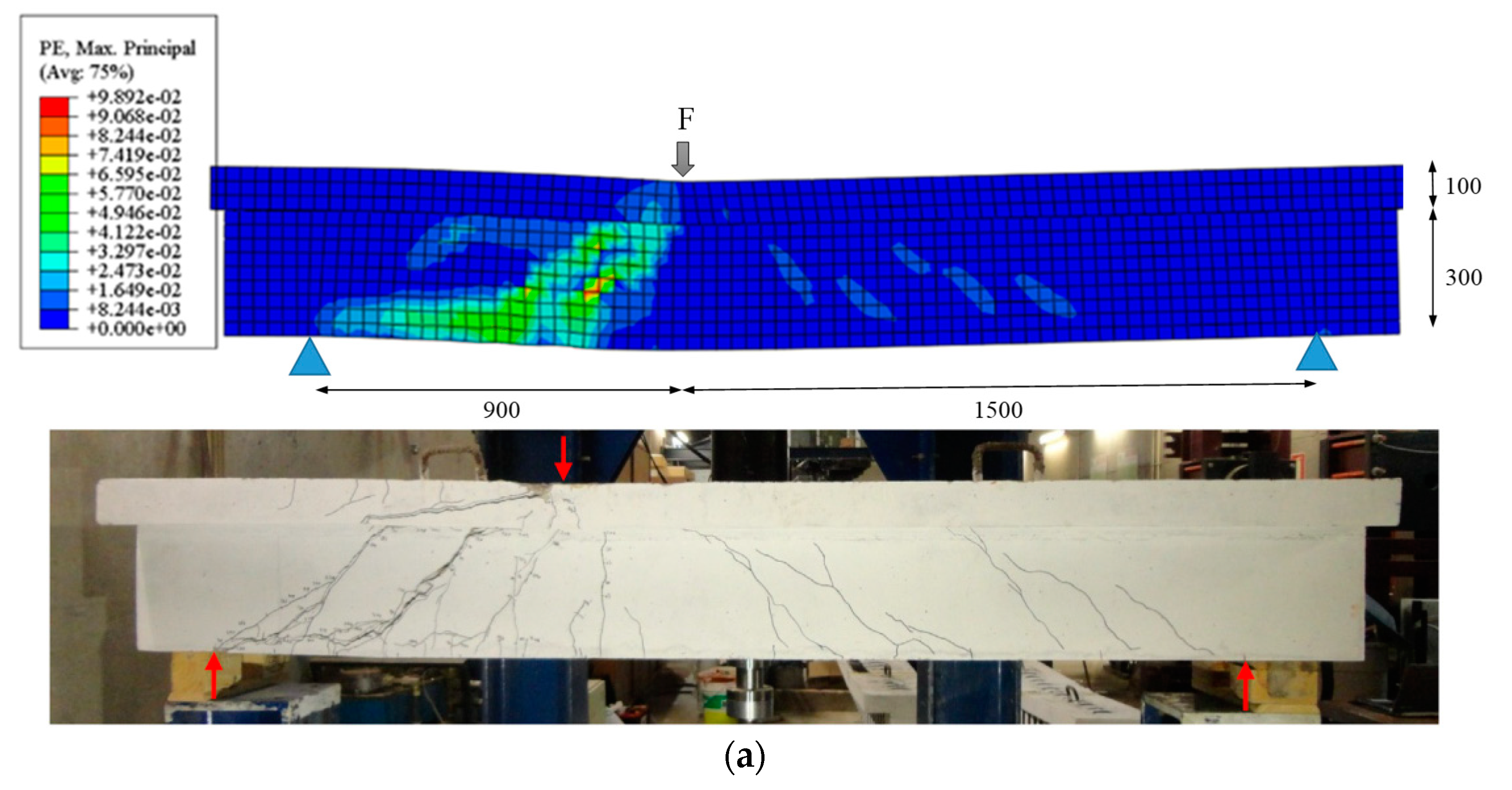
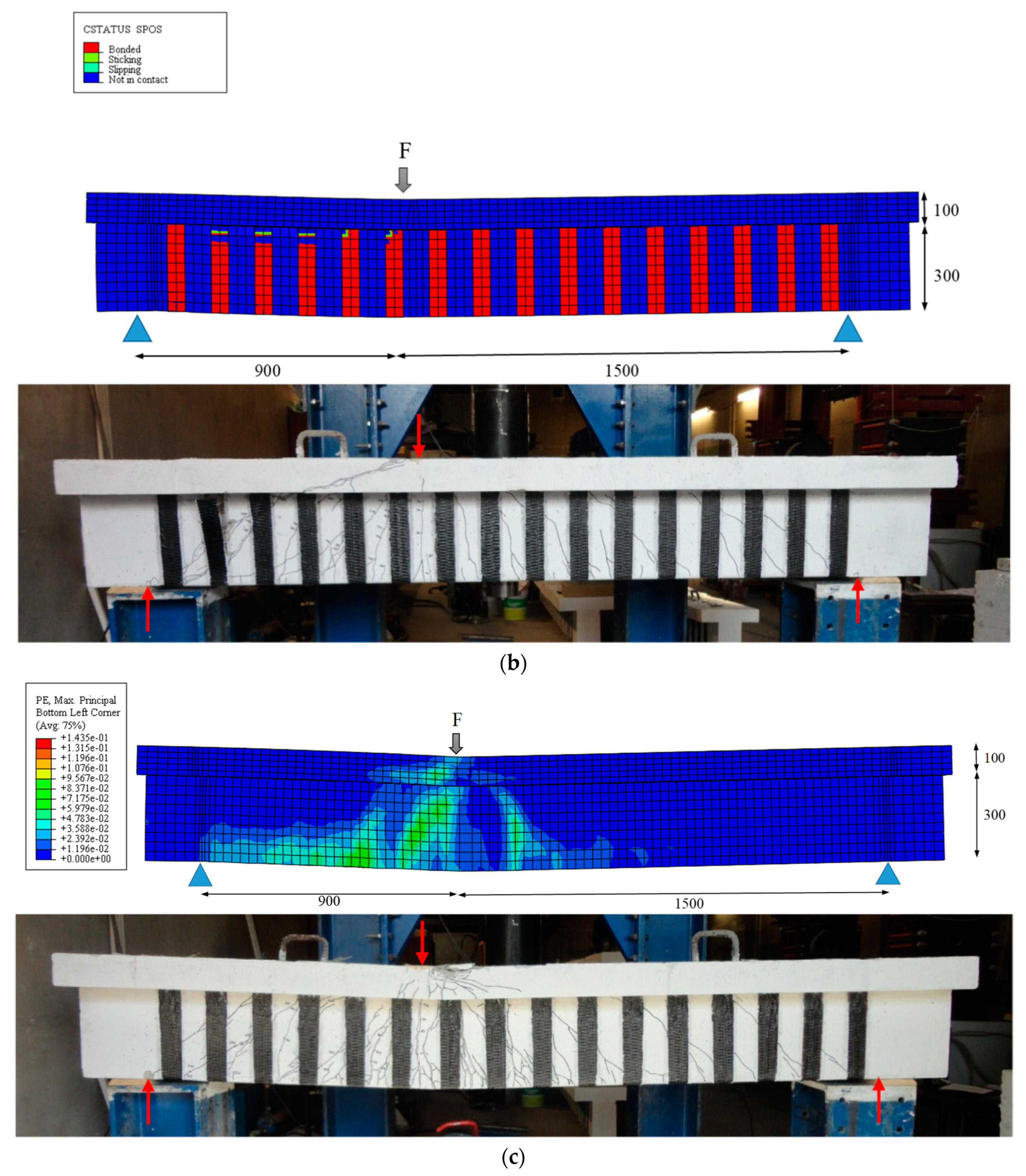
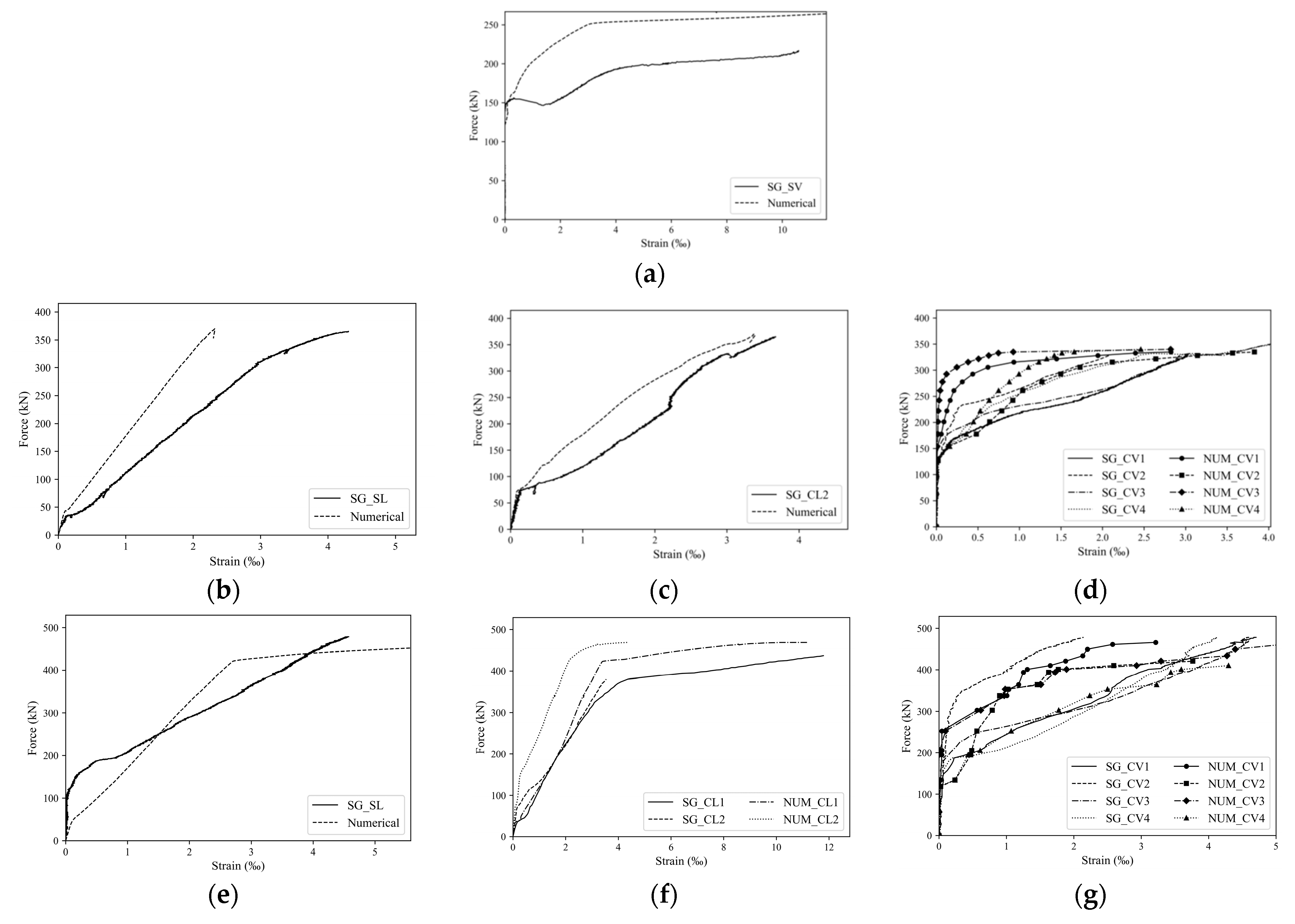





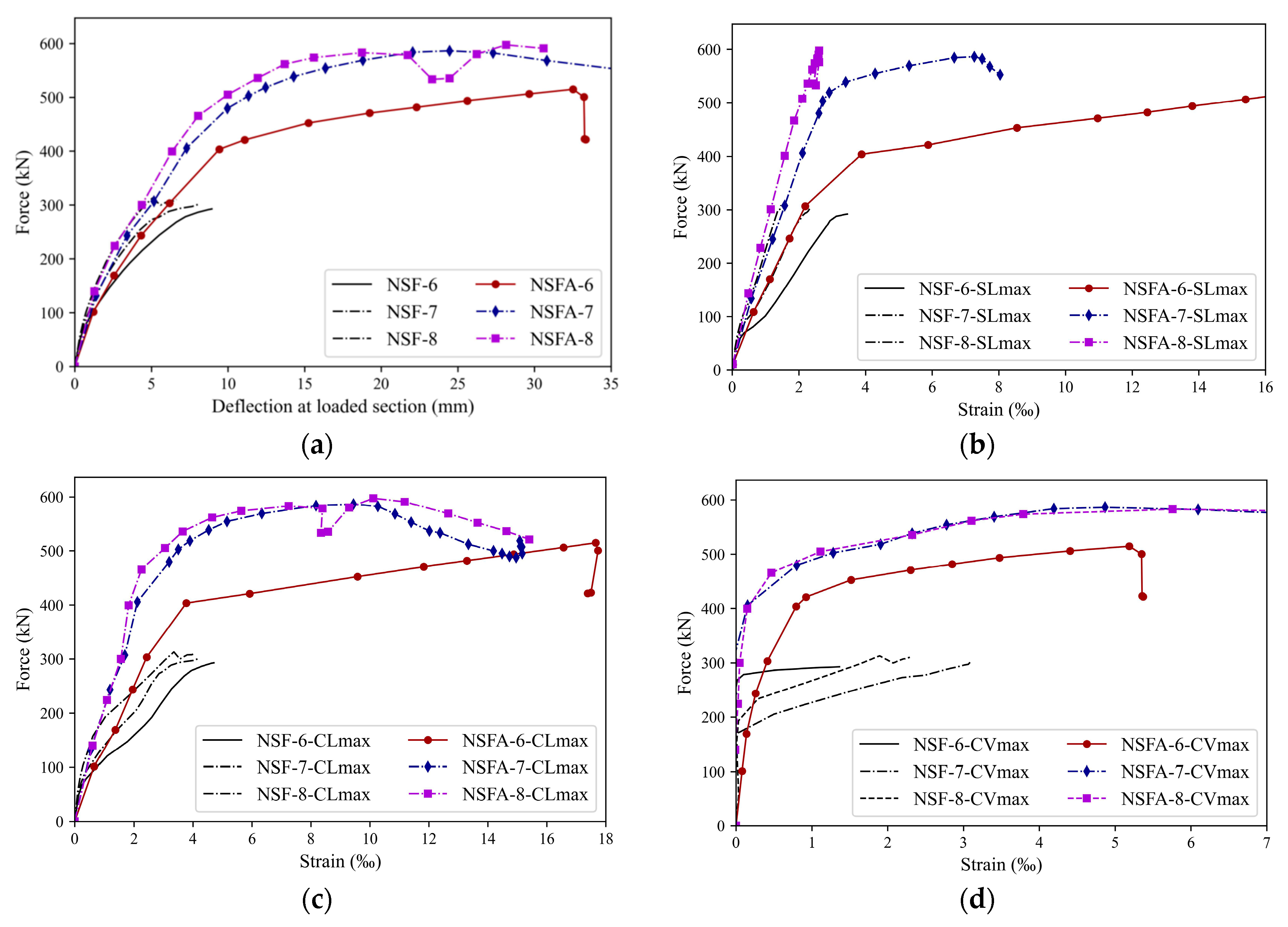
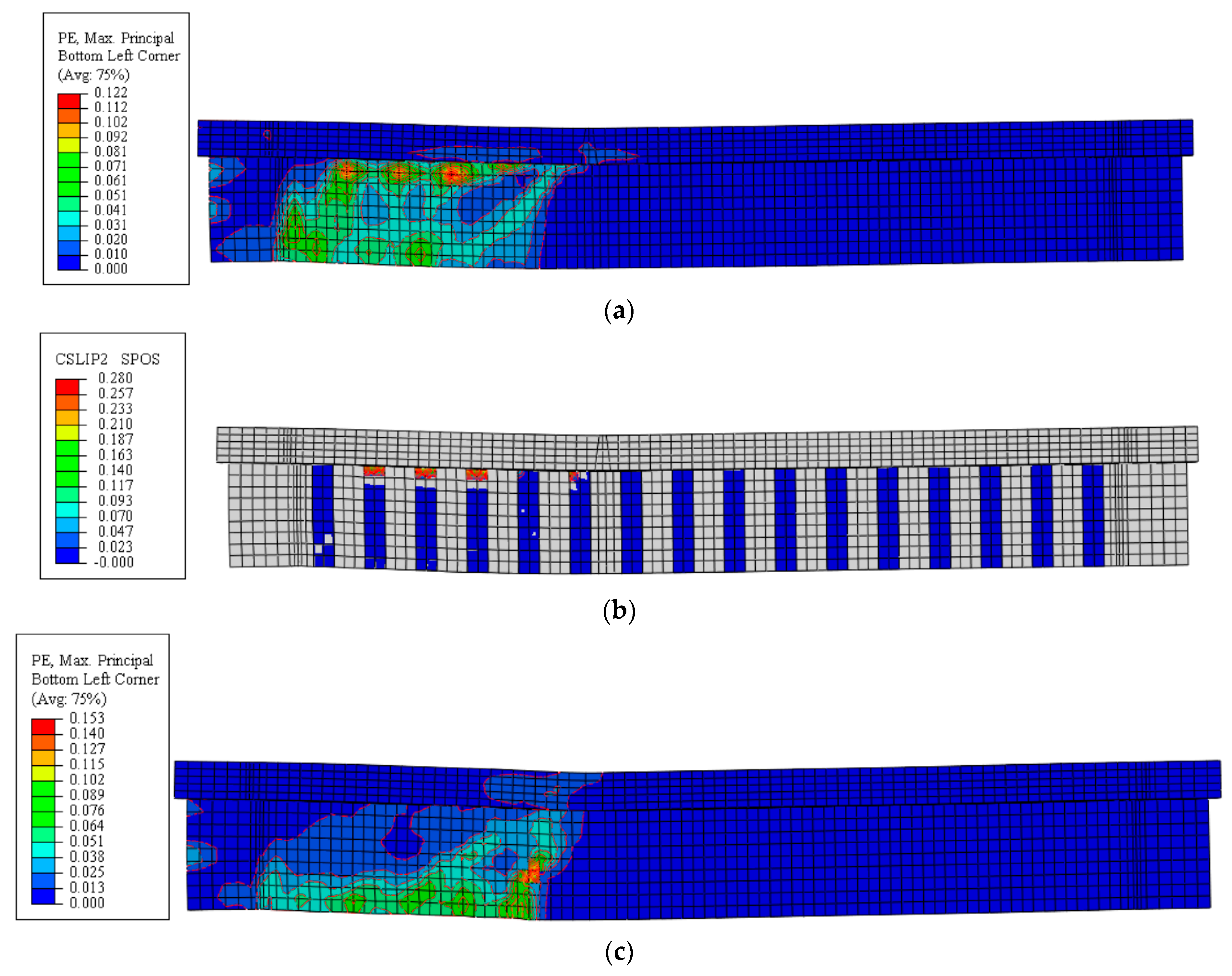
| Beam | 1 (%) | CFRP Flexural Strengthening | 3 (%) | CFRP Shear Strengthening | ||||
|---|---|---|---|---|---|---|---|---|
| Technique | 2 (%) | Technique | 4 (%) | Anchorage | ||||
| REF-I | Series I | 1.46 | - | - | 0.1 | - | - | - |
| SFS-I | 1.46 | NSM | 0.08 | 0.1 | EBR | 0.16 | No | |
| SFSA-I | 1.46 | NSM | 0.08 | 0.1 | EBR | 0.16 | Yes | |
| REF-II | Series II | 1.74 | - | - | 0.21 | - | - | - |
| SFS-II | 1.74 | NSM | 0.08 | 0.21 | EBR | 0.08 | No | |
| SFSA-II | 1.74 | NSM | 0.08 | 0.21 | EBR | 0.08 | Yes | |
| Beam | Fmax (kN) | uLS (mm) | Failure Mode | CFRP Maximum Strains (‰) | |||||
|---|---|---|---|---|---|---|---|---|---|
| CL1 | CL2 | CV1 | CV2 | CV3 | CV4 | ||||
| REF-I | 310.3 | 12.54 | Shear | - | - | - | - | - | - |
| SFS-I | 365.1 | 10.44 | Shear | - | 3.7 | 3.0 | 2.1 | 4.3 | 4.4 |
| SFSA-I | 479.0 | 28.59 | Flexural | 12.1 | 3.6 | 4.7 | 2.2 | 4.6 | 4.2 |
| REF-II | 349.5 | 14.89 | Shear | - | - | - | - | - | - |
| SFS-II | 411.4 | 9.22 | Shear | 3.9 | 2.7 | 0.8 | 1.4 | 4.7 | 8.2 |
| SFSA-II | 526.2 | 33.23 | Flexural | 15.3 | 10.6 | 4.9 | 2.1 | 3.1 | 6.6 |
| Parameters | Values |
|---|---|
| Dilation angle, (Degree) | 40 |
| e | 0.1 |
| 1.16 | |
| Kc | 0.667 |
| (MPa) | 2.1 |
| (N·m) | 100 |
| 0.2 | |
| 0.05 | |
| Crack bandwidth: | |
| Mesh 30 mm | 30 mm |
| Mesh 35 mm | 35 mm |
| Mesh 50 mm | 50 mm |
| (REF-I, REF-II, SFS-I, and SFS II beams) [32] | 0.0 |
| ((SFSA-I and SFSA-II beams) [32] | 0.26 |
| (MPa) | 44.3 |
| (GPa) | 27.28 |
| * | 0.0045 |
| No. | Model ID | Flexural Strengthening Ratio with NSM CFRP Laminates— (%) | Shear Strengthening Ratio with EBR CFRP Strips— (%) | Flexural Reinforcement Ratio of Longitudinal Steel Bars— (%) | Anchorage |
|---|---|---|---|---|---|
| 1 | NSF-1 | 0.06 | 0.08 | 0.97 | No |
| 2 | NSF-2 | 0.09 | 0.08 | 0.97 | No |
| 3 | NSF-3 | 0.12 | 0.08 | 0.97 | No |
| 4 | NSF-4 | 0.08 | 0.16 | 0.97 | No |
| 5 | NSF-5 | 0.08 | 0.24 | 0.97 | No |
| 6 | NSF-6 | 0.08 | 0.08 | 1.28 | No |
| 7 | NSF-7 | 0.08 | 0.08 | 1.83 | No |
| 8 | NSF-8 | 0.08 | 0.08 | 2.28 | No |
| 9 | NSFA-1 | 0.06 | 0.08 | 0.97 | Yes |
| 10 | NSFA-2 | 0.09 | 0.08 | 0.97 | Yes |
| 11 | NSFA-3 | 0.12 | 0.08 | 0.97 | Yes |
| 12 | NSFA-4 | 0.08 | 0.16 | 0.97 | Yes |
| 13 | NSFA-5 | 0.08 | 0.24 | 0.97 | Yes |
| 14 | NSFA-6 | 0.08 | 0.08 | 1.28 | Yes |
| 15 | NSFA-7 | 0.08 | 0.08 | 1.83 | Yes |
| 16 | NSFA-8 | 0.08 | 0.08 | 2.28 | Yes |
| Beam | Maximum Load [kN] | Strain SLmax [‰] | Strain CLmax [‰] | Strain CVmax [‰] | Load Capacity ACI 440.2R-17 [kN] | Load Capacity fib90 [kN] | Fnum/Fana ACI440 | Fnum/Fana fib90 | Failure Mode (1) |
|---|---|---|---|---|---|---|---|---|---|
| NSF-1 | 315.98 | 8.32 | 12.40 | 5.78 | 313.0 | 288.2 | 1.01 | 1.10 | S |
| NSF-2 | 291.82 | 3.59 | 6.19 | 5.80 | 313.0 | 288.2 | 0.93 | 1.01 | S |
| NSF-3 | 288.39 | 2.87 | 6.30 | 6.00 | 313.0 | 288.2 | 0.92 | 1.00 | S |
| NSF-4 | 298.97 | 5.08 | 6.84 | 2.39 | 349.4 | 345.4 | 0.86 | 0.87 | S |
| NSF-5 | 296.44 | 4.09 | 5.63 | 1.86 | 370.1 | 389.3 | 0.80 | 0.76 | S |
| NSF-6 | 300.88 | 3.46 | 5.41 | 1.36 | 313.0 | 288.2 | 0.96 | 1.04 | S |
| NSF-7 | 300.89 | 2.33 | 4.21 | 3.08 | 313.0 | 288.2 | 0.96 | 1.04 | S |
| NSF-8 | 312.85 | 1.47 | 4.08 | 2.29 | 313.0 | 288.2 | 1.00 | 1.09 | S |
| NSFA-1 | 399.82 | 17.43 | 17.88 | 3.86 | 304.4 | 338.6 | 1.31 | 1.18 | F |
| NSFA-2 | 431.65 | 20.09 | 17.16 | 6.12 | 334.3 | 380.8 | 1.29 | 1.13 | F |
| NSFA-3 | 456.13 | 16.47 | 16.63 | 6.81 | 364.1 | 422.9 | 1.25 | 1.08 | F |
| NSFA-4 | 420.61 | 20.27 | 16.69 | 4.26 | 324.4 | 366.8 | 1.30 | 1.15 | F |
| NSFA-5 | 428.41 | 17.74 | 17.86 | 2.32 | 324.4 | 366.8 | 1.32 | 1.17 | F |
| NSFA-6 | 514.83 | 20.95 | 17.74 | 5.37 | 398.8 | 440.5 | 1.29 | 1.17 | F |
| NSFA-7 | 518.42 | 8.04 | 15.17 | 11.53 | 527.8 | 569.2 | 0.98 | 0.91 | F |
| NSFA-8 | 465.59 | 2.61 | 15.41 | 11.00 | 629.8(F) 313.0(S) | 672.7(F) 288.2(S) | 0.74(F) 1.49(S) | 0.69(F) 1.62(S) | F |
| Average | 1.06 (2) | 1.02 (2) | |||||||
| CoV | 0.18 (2) | 0.14 (2) |
Disclaimer/Publisher’s Note: The statements, opinions and data contained in all publications are solely those of the individual author(s) and contributor(s) and not of MDPI and/or the editor(s). MDPI and/or the editor(s) disclaim responsibility for any injury to people or property resulting from any ideas, methods, instructions or products referred to in the content. |
© 2024 by the authors. Licensee MDPI, Basel, Switzerland. This article is an open access article distributed under the terms and conditions of the Creative Commons Attribution (CC BY) license (https://creativecommons.org/licenses/by/4.0/).
Share and Cite
Ayyobi, P.; Barros, J.A.O.; Dias, S.J.E. Numerical Assessment of the Effect of CFRP Anchorages on the Flexural and Shear Strengthening Performance of RC Beams. J. Compos. Sci. 2024, 8, 348. https://doi.org/10.3390/jcs8090348
Ayyobi P, Barros JAO, Dias SJE. Numerical Assessment of the Effect of CFRP Anchorages on the Flexural and Shear Strengthening Performance of RC Beams. Journal of Composites Science. 2024; 8(9):348. https://doi.org/10.3390/jcs8090348
Chicago/Turabian StyleAyyobi, Pedram, Joaquim António Oliveira Barros, and Salvador José Esteves Dias. 2024. "Numerical Assessment of the Effect of CFRP Anchorages on the Flexural and Shear Strengthening Performance of RC Beams" Journal of Composites Science 8, no. 9: 348. https://doi.org/10.3390/jcs8090348





